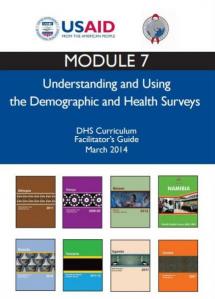Collecting Data on Malaria in National Surveys
This manual is Module #7 of the DHS Curriculum Facilitators Guide. The DHS Curriculum Facilitator’s Guide is a comprehensive package of ready-made training materials about understanding and using Demographic and Health Survey reports. The module is intended to be a 3 hour training activity, and it offers the following instruction:
- Explains indicators for malaria
- Describes how the DHS estimates malaria prevalence
- Discusses DHS results on malaria from six countries in sub-Saharan Africa.
By the end of this module, participants should be able to:
- Discuss malaria epidemiology in Sub-Saharan Africa
- Describe DHS surveys and how The DHS Program estimates malaria and anemia prevalence
- Discuss the type of data and indicators The DHS Program collects
- Explain how to correctly interpret trends in malaria prevalence
- Discuss the latest DHS malaria indicators in six countries
Last modified: March 25, 2019
Language: English

